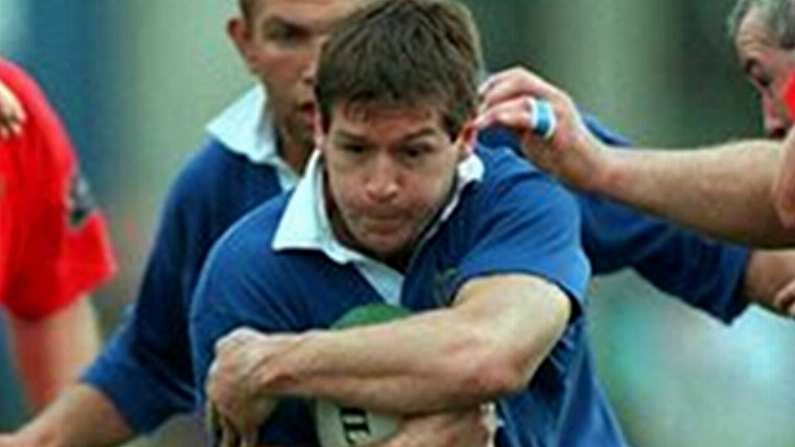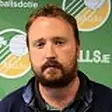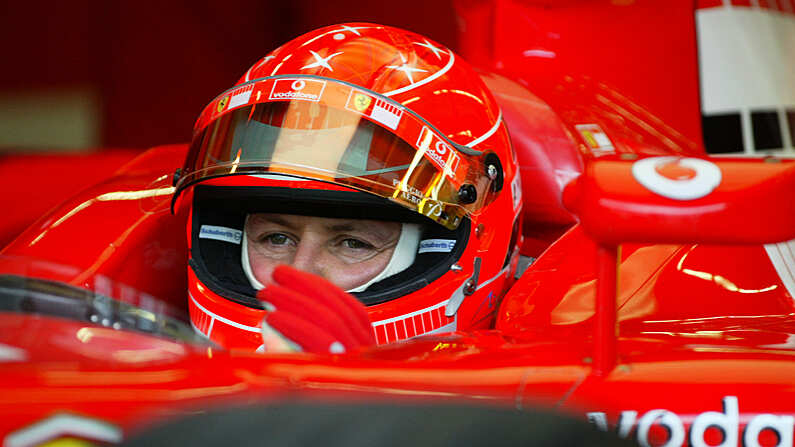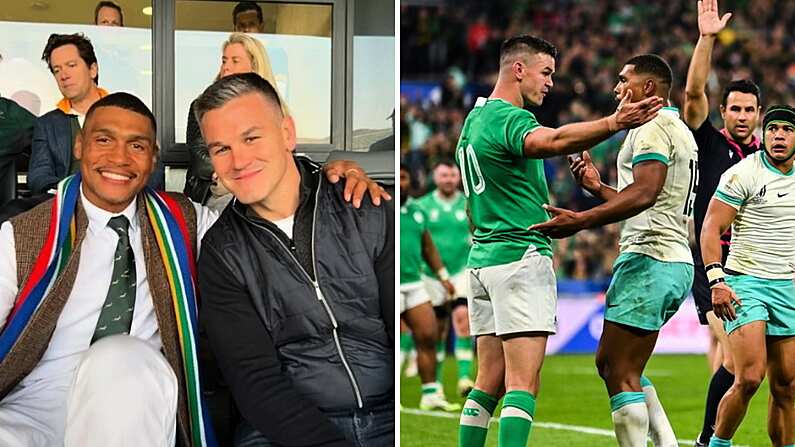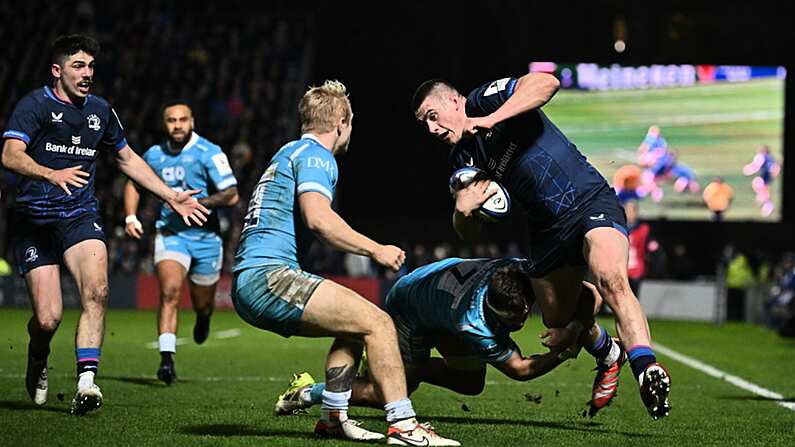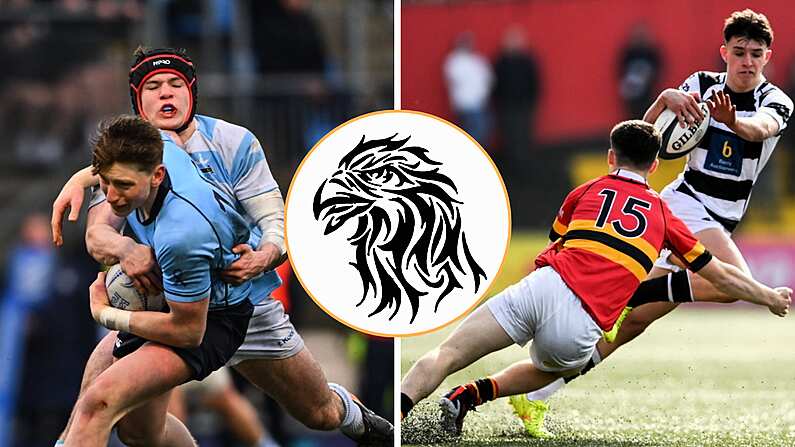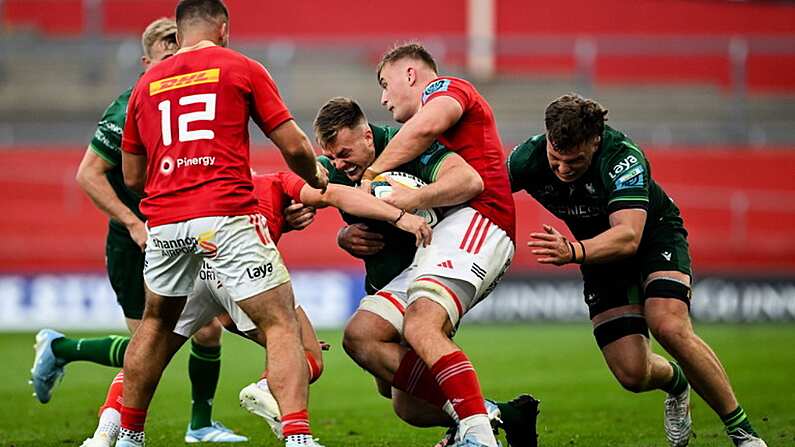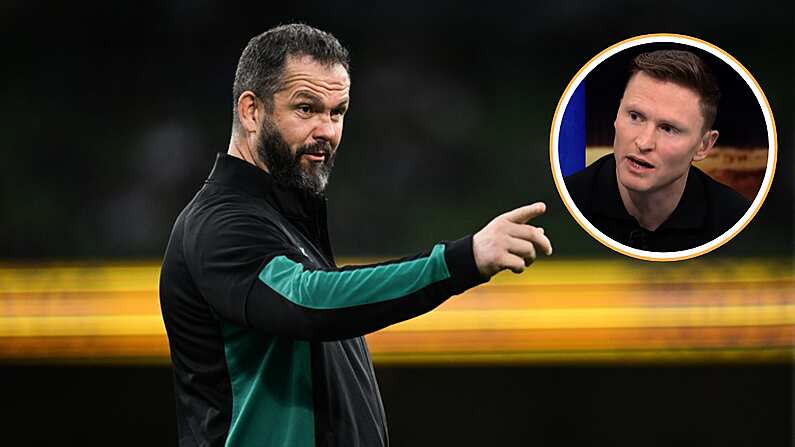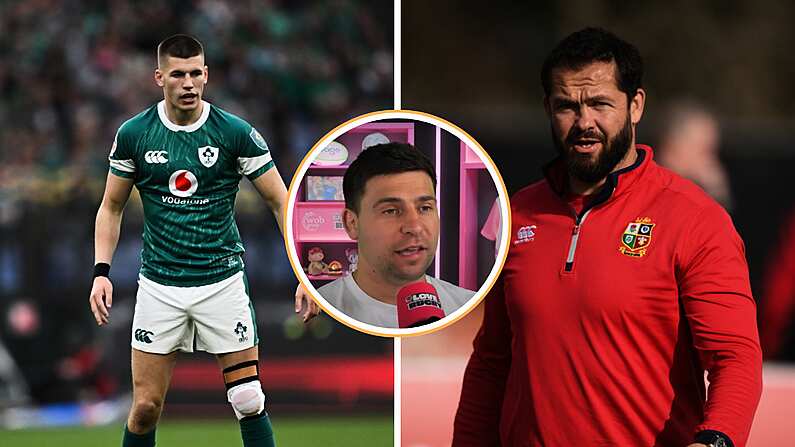Ahead of a weekend where Leinster could equal Toulouse's record-haul of four European Champions Cup victories, we share this detailed look back at the first Leinster side to dip its toes into the competition in 1995.
Making the trip to Milan to take on a side no longer in existence, an awful lot has happened in the intervening years.
I think it was played on a Wednesday afternoon at 4 o’clock. It was played in Milan and I'd say there was about 600 people at it. There was no Leinster supporters, just a few committee people. It was played on a pitch surrounded by a running track.
Jim Glennon, Leinster Head Coach
It's hard to believe from this remove with European Cup games involving the provinces regularly attracting sell-out crowds but the above describes the setting for a European encounter involving Leinster.
At a time when the Irish team still lost almost every game they played outside of Cardiff, and the IRFU hierarchy were still traumatised by the arrival of professionalism, Jim Glennon's Leinster side travelled to the inauspicious surrounds of the Stadio Comunale Giuriati to face Milan, the rugby arm of the AC Milan sport club, owned by one Silvio Berlusconi.
The day before Toulouse had beaten Romanian outfit Farul Kostanta in the first ever Heineken Cup game, and a couple of hours earlier, Munster were kicking off against Swansea in front of a rather healthier crowd in Thomand Park.
Niall Woods, the Blackrock and Ireland winger, who scored Leinster's winning try in the game's final quarter, remembers the feeling as they jetted into Milan.
I remember going to Milan and thinking this was the hub of fashion and arriving it was anything but. It was just very industrial where we were. Ireland had played Italy (and lost) in '95 before the World Cup and the Italians conspired, allegedly, that the team bus never arrived to bring Ireland to the match, and so Jim Glennon had to go and do a recce beforehand. The pitch was very bad, there was very few people watching it. There was no travelling support. There might have been a handful of alickadoos but nothing like there is now...
At the time, the provincial game in Ireland was not exactly box-office. Paltry crowds attended the annual inter-provincial championship games every December. The recently established All-Ireland League was where the hype lay. In 1993, a 17,000 strong crowd in Lansdowne Road saw Young Munster defeat St. Mary's 17 - 14 to claim the League title. This is compared to the crowds of between 3 and 4,000 who used to trudge out to inter-provincial matches in winter.
While the players were generally unaware of the big competition that was coming down the tracks, Glennon, Leinster head coach for two separate spells between 1992 and 1998, reckoned it was going to be the start of something.
I think there was a sense of excitement about it, maybe not among the players, but there was a sense that this was the start of something. No doubt about that. I remember ringing Tommy Kiernan on the day we left (for Milan) to thank him. He was on the negotiating body that put the thing together. I think there was an awareness that, while we didn’t know where it was going to go, it was going to take us out of playing three or four matches a year and 3-4,000 people watching Leinster playing Ulster or Munster.
As entities, Leinster and the other provinces occupied a strange position in 1995 and 1996, halfway between a club side and a representative side who played infrequently. For instance, Conor O'Shea was contracted to London Irish, but still returned home to play in Leinster's three Heineken Cup matches that season.
Even after English clubs entered the competition in '96, this practice continued. Paul Wallace signed for Saracens in June 1996 but still played for Leinster against Pau in November of that year. Jim Glennon had to negotiate with the likes of London Irish coach Clive Woodward to secure the release of players to play in Heineken Cup in the first two seasons.
All of this was still in its genesis. There was politics being played all over the place and the English teams weren’t in the competition. And the (English based) players wanted to play in it, and they wanted to play for Leinster because they thought it was their route to the Irish team.
Newspapers still included the name of a player's AIL side in brackets when listing out the team. Nevertheless, Niall Woods attests to the fact that Leinster had become more like a club team that season.
1995-96 was the first year where Leinster played around 10 or 11 games. Before 1995, when you played with your club, you played with your club to play with Leinster, and the club was the primary focus really. But definitely, there was a bit of a shift that year towards Leinster being a club. You were certainly with Leinster a lot as opposed to previous years.
The game itself was an extremely anxious affair, as Leinster conceded penalty after penalty, having gotten on the wrong side of the French referee (who Woods describes as "atrocious"). They were extraordinarily fortunate that Milan's celebrated out-half Diego Dominguez had a very rare off day, missing seven attempts from ten.
The thing the players most remember from the match was the shuddering violence of it. The rough and ready Italians were generous when it came to doling out skelps. Paul Wallace remembers it as a hair-raising, anarchic encounter.
There was no video cameras there so there was a lot of punches going around. I do remember having my life saved by Brian Rigney, our second row, after one of these when I was lying on the ground and a 25 stone second row was looking like he was targetting my head only to be nudged by Brian. Poor Dean Oswald was lucky to come out with his head intact as well...
Leinster led at half-time, 14 - 8, aided by a try from Ireland full-back Conor O'Shea. However, after a barrage of pressure in the third quarter, they conceded 10 points without reply. On 66 minutes, came the game's defining moment, when Woods collected a ball on the halfway line, beat his man on the outside, stepped inside the next defender and sped 50 yards to touch the ball down under the posts.
I think it was about the only pass I got in the whole game, which was nothing new in those days anyway (laughs). I got it off the out-half, I remember there was a ruck in the middle of the pitch and I think I just stepped someone and was through and then just legged it, just put the boot down.
While Sky Sports did broadcast that season's final, they did not drop everything to show the action from Milan. Jim Glennon does recall seeing Woods' famous try on television later that week.
I did see Niall Woods' try on television later on. There was a round-up of the tries from the games but, I’ll put it to this way, the camera work left a lot to be desired even by the standards of 20 years ago
Leinster eventually won the match 24 - 21, gratefully witnessing Diego Dominguez's attempt to level it in the final minute again slide wide. It was a decent win in the circumstances. Two years later, Leinster would travel to Milan and lose 33 - 32.
The 1995-98 era represents the forgotten pre-history of the Heineken Cup, when professionalism, particularly in Ireland, was still in infancy, and when the cream of Irish rugby were still slaving away in the Guinness Premiership week after week. A couple of years ago, when Leinster played their 100th Heineken Cup match, Glennon and others attempted to hold a reunion dinner for the side that played the first game back in '95, but ultimately these plans weren't followed through on.
The next day out, Leinster defeated Pontypridd 23 - 22 in Donnybrook thanks to a late Alan McGowan penalty. They topped the three-team pool and went on to play Cardiff in Lansdowne Road in the semi-final on 30 December '95. They were beaten 23 - 14.
As far as the IRFU were concerned, it was perhaps just as well. They had scheduled an Irish international in the US on the day of the final. Had Leinster won the semi-final, they would have faced Toulouse in the Cardiff Arms Park with half a team.
Nonetheless, Woods, who was sidelined with a hamstring injury, remembers the Cardiff game as the moment when the significance and potential of this new competition started to hit people.
The buzz I think, for me, came when we got the semis... In those days you didn't really play in Lansdowne Road so then the importance of the thing dawned on people. And then I remember watching the final and thinking this is actually quite big.
Here is the Leinster team that lined out against Milan:
15. Conor O'Shea
O'Shea scored Leinster's first ever try in the Heineken Cup when he touched down in Milan. However, 1995 was to be his final year with the side as he became one of many Irish players to leave for the Premiership in 95 and 96, joining Clive Woodward's London Irish side.
He played 35 times for Ireland between 1993 and 2000. Highlights include the win over England in Twickenham in 1994, the victory over Wales at Wembley in 1999, and playing every game for Ireland at the 1995 Rugby World Cup. His final game came in the crushing defeat to England in the opening game of the 2000 Six Nations before he was replaced for the following week by Girvan Dempsey.
He later went on to become one of the most respected coaches in the game and is currently in charge of the Italian national team.
14. Paddy Gavin
Gavin had been a regular on the Leinster inter-provincial side since 1993. The Old Belvedere player remained an amateur throughout the early Heineken Cup period, according to Glennon. As a result of job commitments, there was never really any question of him turning pro.
"Paddy was a definite amateur at that time. He wasn't even able to guarantee he was able to train with us," says Glennon. Gavin's final Heineken Cup game for Leinster was in the 27 - 10 defeat to Leicester in Lansdowne Road in October 1996.
He currently works as a doctor in Crumlin Children's hospital.
13. Vinnie Cunningham
Cunningham is best known for sliding in two first half tries in Dunedin when Ireland (slap bang in the middle of possibly our worst run ever) almost stunned New Zealand in the summer of 1992. The All-Blacks eventually won 24-21. The St. Mary's man toured with the Lions in 1993, having featured in every match of Ireland's heartening '93 Five Nations campaign. His final game for Ireland was in a bad defeat in the Parc des Princes in the opening game of the 1994 Five Nations. His international career was hampered by a dreadful knee injury he suffered when playing for St. Mary's in 1994.
He went on to serve as backs coach for St. Mary's in the early 2000's.
He currently heads up his own accountancy firm and is an executive director of the housing charity, Habitat for Humanity Ireland.
12. Kurt McQuilkin
McQuilkin arrived in Ireland at the age of 27 to play for Bective Rangers before the start of the 1993/94 season. Not coincidentally, his father Noel was the coach at Bective at the time. He was selected by Jim Glennon to play for Leinster for the 1995 showdown against the Natal alongside fellow Kiwi debutant Dean Oswald. He played four seasons for Leinster in the Heineken Cup between 1995/96 and 1998/99.
Unlike his Kiwi team mate Oswald, McQuilkin stuck around long enough to complete the naturalisation process and played five times for Ireland in 1996 and 97.
He later served as Leinster's defence coach during Michael Cheika's reign and would return again in 2015 under Leo Cullen, but would have to return to New Zealand the following year to spend time with his sister and father who were both suffering with cancer.
11. Niall Woods
Scored a fantastic solo try in the second half of the game which secured victory in Milan.
Woods was a key player in Eddie O'Sullivan's Blackrock side of the mid-90s and was a fixture in the Leinster inter-provincial side since the early 90s. Gerry Thornley billed him as "the most exciting runner in Irish rugby" after Leinster's demolition of Ulster in the 1993 interpros match (amazingly this was the first time Ulster had lost a match in that competition in exactly a decade). He left for London Irish after the 1995/96 season where he remained until 2000 before he played for a brief spell at Harlequins.
Woods played eight times for Ireland, between 1994 and 1999, scoring the final try in Ireland's victory over Wales in the 1996 Five Nations at Lansdowne Road.
He currently manages his own sports agency.
10. Alan McGowan
The Blackrock out-half occupied the Leinster 10 jersey between 1992 and 1998. He started against the all-conquering Australian touring side in 1992, thanks to an injury to regular out-half Paul Hennebry, and became first choice fly-half from the 1993 interprovincial championship onwards, tussling occasionally with Terenure's Richie Governey.
He played once for Ireland against the United States in November 1994.
9. Alain Rolland
Much better known now as an international referee, Alain Rolland played roughly 40 times for Leinster between 1989 and 1996. He left to play for Moseley in the English Second Division in late 1996 but returned to play for Wanderers for the 1997-98 season, by which stage he was already dipping his toes in the refereeing game in the AIL.
He was capped three times for Ireland. He started in the narrow win over Argentina in 1990 (his only start) while he came on as a replacement in both the 1994 victory over the USA and the World Cup warm-up game loss to Italy in Treviso in 1995. He also played in the AIL for Blackrock until 1996.
Rolland scored the winning try in the inter-provincial championship against Munster in December 1995, Leinster's last win in Thomand Park until 2010.
1. Henry Hurley
Old Wesley's Hurley played for Leinster during the first two seasons of the Heineken Cup. Towards the end of 1996 he left for Moseley RFC along with Alain Rolland and Blackrock's Martin Ridge.
He was capped twice for Ireland in the victory over Fiji in 1995 and loss to Samoa in November 1996. He went to the World Cup in South Africa in 1995, but didn't play.
He works as a teacher in East Glendalough in Wicklow.
2. Shane Byrne
Byrne, a Leinster stalwart, played for Leinster between 1993 and 2005, traversing both the amateur and professional eras. He missed Leinster's 1996/97 campaign He took off to Saracens in the summer of 2005, apparently irked by the foot-dragging of the Union in the contract negotiations.
Byrne first got in the Ireland squad in 1993 but was unable to break into the team ahead of Terry Kingston and then Keith Wood and later, briefly, Frankie Sheahan. He was eventually to make his Ireland debut against Romania in 2001, was an ever-present during the 2003, 2004, and 2005 Six Nations championships. He also featured in the 2005 Lions tour.
He also appeared on Tonight with Vincent Browne defending alcohol sponsorship in sport and had been approached by Fine Gael to contest the 2014 local elections but ultimately declined.
3. Paul Wallace
A Munster man exiled in Dublin, Wallace opted to play for Leinster during the 1995/96 season. He had been playing for Blackrock since 1993 and switched allegiance to Leinster in August '95 for "business and domestic reasons." He made his debut for Munster in 1993 but was unable to make the side which won the Inter-provincial side in 1994/95 ahead of John 'Paco' Fitzgerald and Peter Clohessy (the first time Ulster hadn't won the interpros in about a decade).
Wallace left for Saracens in June 1996 on a three year contract. In spite of this, he still togged out for Leinster in their 25 -23 defeat of Pau in Donnybrook in the 1996/97 Heineken Cup clash.
After leaving Saracens in 2001, he returned to Leinster. In his second spell with the province, he usually played second fiddle to Emmet Byrne, but he started on the team that won the inaugural Celtic League Final against Munster in December 2001. He retired in 2003.
Wallace had a distinguished international career, playing 45 times for Ireland between 1995 and 2002. Internationally, he is best known for being one of the stars of the memorable 1997 Lions tour of South Africa.
He works as a rugby analyst with Sky Sports.
4. Malcolm O'Kelly
The only survivor from that day to stick around long enough to win a Heineken Cup medal, O'Kelly made his Leinster debut in Milan. He left for London Irish after the 1995-96 season as part of that summer's mass exodus to England. He stayed with 'Irish' for four years until moving back to play for Leinster in 2000.
He made his Ireland debut in 1997 and made his final appearance as a sub in Ireland's victory in Rome during the Grand Slam year of 2009. In total, he earned 91 caps for Ireland and is a former record Irish cap holder, breaking Mike Gibson's longstanding record tally in 2005.
He now works as an orthopaedic specialist in Dublin.
5. Brian Rigney
At 32 years of age, Rigney, a Heineken sales rep at the time, was eleven years older than his callow second row companion. The hugely experienced Portlaoise man played for Leinster on numerous occasions throughout the 80s and 90s. His final game for the province was the 23-22 victory over Pontypridd in that year's European Rugby Cup, before he was replaced by the returning Neil Francis.
Rigney was capped eight times for Ireland in 1991 and 1992, though, this being a rather bleak time for Irish rugby, he was never to finish on the winning side, and the only non-loss was the 21-21 draw with Wales in the 1991 Five Nations. Rigney also played well in Ireland's stirring but agonisingly narrow loss to New Zealand in Dunedin in 1992. Throughout the period, he played club rugby for Bective Rangers, Greystones, Shannon, and Buccaneers.
Paul Wallace credited Rigney with saving his life early in the game. Rigney was another non-Dub in a pack full of non-Dubs. Despite this, Glennon says the team were still subject to the usual taunts.
An interesting thing about that team, if you look at the pack particularly, you had Henry Hurley from Wicklow, Shane Byrne from Wicklow, Paul Wallace, Corkman living in Dublin, Brian Rigney from Laois, Malcolm O’Kelly from Dublin, Chris Pim from Laois, Dean Oswald a New Zealander, and Victor Costello from Wicklow. There was only one Dub and we had the thing, even at that stage, the old D4 thing was being thrown around and the old Dublin softies…
He works as a sales rep for the Findlater Wines and Spirits Group, covering the Leinster region.
6. Chris Pim (Capt.)
The veteran Chris Pim captained Leinster that day in Milan. His rugby career began 13 years earlier, when he lined out for Old Wesley as an 18 year old in 1982. Pim made his first appearance for Leinster in 1988 and retired in 1997. He was never capped for Ireland. He told the Irish Independent a couple of years ago.
Part of my reason for finishing was that I could feel myself starting to creak. I wanted to be able to go out and kick a ball with my kids. I definitely lived in the best of both worlds, starting amateur and finishing as a semi-professional. I got a taste of life as a pro but I also had the olden days of the crack and the pints.
He currently owns two McDonalds franchises, one in Kilkenny, and one in Dungarvan.
7. Dean Oswald
Oswald, a very highly regarded Kiwi back rower, was brought to Blackrock in 1993 by their then coach Eddie O'Sullivan, having already played three seasons for Pontypool between 1990 and 1992. Oswald played brilliantly at no. 8 for Blackrock in their run to the 1994 AIL final (where they lost to Garryowen) and was hailed as the star on a team that contained players like the stylish Brendan Mullin and the pacy Niall Woods.
"He was outstanding, absolutely outstanding. If the naturalisation laws were in place in those days that are in place now, he would have been an Irish international," says Glennon.
The fearsome back rower returned to New Zealand in 1997 but didn't forget the Irish setup and popped along to watch Brian Ashton's side face King Country on Ireland's harrowing tour of New Zealand that summer. Oswald currently works as a policeman in his home town of Whakatane in New Zealand. In 2013, he made national headlines by dramatically rescuing a man and two boys from drowning while on holiday in the Bay of Plenty.
8. Victor Costello
A Leinster legend, Costello represented Ireland in the shot put at the 1992 Olympics, and won five Irish shot put titles in a row between 1987 and 1991. He began his AIL career at Blackrock in 1992 before switching to St. Mary's in 1994. He ultimately made his debut for Leinster against the Natal in the summer of 1995. After the 1995-96 season, he joined the Irish exodus to the Courage League in England when he left for London Irish. However, in early 1997 he grew fed up and returned to St. Mary's.
Costello earned 39 caps for Ireland between 1996 and 2004, usually vying with Munster's Anthony Foley for the No. 8 slot.
He currently works as a first officer with Ryanair.
Management team:
Head Coach: Jim Glennon
Forwards Coach: Ciaran Callan, Backs Coach: Paul Dean

